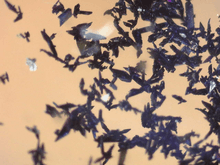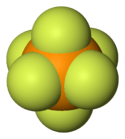Hexafluorophosphate
| |||
| Names | |||
|---|---|---|---|
| IUPAC name
Hexafluorophosphate | |||
| Systematic IUPAC name | |||
| Identifiers | |||
| 3D model (Jmol) | Interactive image | ||
| ChEBI | CHEBI:30201 | ||
| ChEMBL | ChEMBL181124 | ||
| ChemSpider | 9502 | ||
| 2704 | |||
| PubChem | 9886 | ||
| |||
| |||
| Properties | |||
| F6P− | |||
| Molar mass | 144.964181 g mol−1 | ||
| Except where otherwise noted, data are given for materials in their standard state (at 25 °C [77 °F], 100 kPa). | |||
| | |||
| Infobox references | |||
Hexafluorophosphate is an anion with chemical formula of PF−
6. This octahedral species is isoelectronic with sulfur hexafluoride, SF6, and the hexafluorosilicate dianion, SiF62−, and is valence isoelectronic with the highly stable superacid anion fluoroantimonate SbF−
6. As a non-coordinating anion,[2][3][4] it is a poor nucleophile. It is prone to decomposition with the release of hydrogen fluoride in ionic liquids[5] but is generally extremely stable in solution. Hydrolysis to the phosphate ion is very slow even in concentrated acid with warming,[6] and even slower under basic conditions.[7]
Synthesis

Hexafluorophosphate salts can be prepared by the reaction of phosphorus pentachloride and alkali or ammonium halide in a solution of hydrofluoric acid:[8]
- PCl5 + MCl + 6 HF → MPF6 + 6 HCl
Hexafluorophosphoric acid can be prepared by direct reaction of hydrogen fluoride with phosphorus pentafluoride.[9] It is a strong Brønsted acid that is typically generated in situ immediately prior to its use.
- PF5 + HF → HPF6
These reactions require specialized equipment to safely handle the hazards associated with hydrofluoric acid solution and hydrogen fluoride gas.
Quantitative analysis
Quantitative analysis is an area of analytical chemistry used to determine the amount of a species present in a sample. Several methods of quantitative analysis for the hexafluorophosphate ion have been developed. Tetraphenylarsonium chloride, [(C6H5)4As]Cl, has been used both for titrimetric[10] and gravimetric[11] quantifications of hexafluorophosphate. Both of these determinations depend on the formation of tetraphenylarsonium hexafluorophosphate:
- [(C6H5)4As]+ + PF6− → [(C6H5)4As]PF6
Hexafluorophosphate can also be determined spectrophotometrically with ferroin.[12]
Properties
Non-coordinating anions are anions that interact only weakly with cations, a useful property when studying highly electrophilic cations.[13] In coordination chemistry, the term can also be used to refer to anions which are unlikely to bind directly to the metal centre of a complex. Hexafluorophosphate is a non-coordinating anion in both senses of the term.[3][4] Three widely used non-coordinating anions are hexafluorophosphate, tetrafluoroborate BF−
4, and perchlorate ClO−
4; of these, the hexafluorophosphate ion has the least coordinating ability[14] and it is deliberately used for this property. In the 1990s, a new non-coordinating anion, [B[3,5-(CF3)2C6H3]4]− commonly abbreviated as [BArF4]− and colloquially known as "BARF"[15] was discovered; BARF is far less coordinating than hexafluorophosphate.[16]
Applications
Practical uses of the hexafluorophosphate ion typically exploit one or more of the following properties: that it is a non-coordinating anion; that hexafluorophosphate compounds are typically soluble in organic solvents, particularly polar ones, but have low solubility in aqueous solution; or, that it has a high degree of stability, including resistance to both acidic and basic hydrolysis.
Secondary batteries
The main commercial use of hexafluorophosphate is as its lithium salt, lithium hexafluorophosphate. This salt, in combination with dimethyl carbonate, is a common electrolyte in commercial secondary batteries such as lithium-ion cells. This application exploits the high solubility of hexafluorophosphate salts in organic solvents and the resistance of these salts to reduction by the alkali metal cathode.[17] Since the lithium ions in these batteries are generally present as coordination complexes within the electrolyte,[18] the non-coordinating nature of the hexafluorophosphate ion is also a useful property for these applications.
Organometallic synthesis
Hexafluorophosphate salts are often included in organometallic syntheses to provide an inert and non-coordinating counterion. Tetrafluoroborate salts are a common alternative choice. One route to such compounds involves reactions with silver hexafluorophosphate with the halide salt. Precipitation of insoluble silver halide salt helps drive this reaction to completion. Since hexafluorophosphate salts are often insoluble in water but soluble in polar organic solvents, even the addition of ammonium hexafluorophosphate (NH4PF6) to aqueous solutions of many organic and inorganic salts gives solid precipitates of hexafluorophosphate salts. This method can have advantages over the silver hexafluorophosphate method in terms of expense and in systems where contamination with metal ions is strongly discouraged. As an example, the microwave synthesis[19] of rhodicinium hexafluorophosphate involves the reaction of cyclopentadiene and rhodium(III) chloride hydrate in methanol. During the workup with methanolic ammonium hexafluorophosphate the product salt precipitates cleanly from the reaction mixture.[20] The overall conversion equation is
- RhCl3.xH2O + 2 C5H6 + NH4PF6 → [(η5-C5H5)2Rh]PF6(s) + 2 HCl + NH4Cl + xH2O
Whilst the hexafluorophosphate ion is generally considered inert and hence a suitable counterion, solvolysis reactions of the hexafluorophosphate ion are known. For example, the tris(solvent) rhodium complex [(η5-C5Me5)Rh(Me2CO)3](PF6)2 undergoes solvolysis when heated in acetone, forming a difluorophosphate-bridged complex [(η5-C5Me5)Rh(μ-OPF2O)3Rh(η5-C5Me5)]PF6.[21][22]
Ionic liquids
Hexafluorophosphate organic salts that are soluble in organic solvents and ionic liquids are well known. The routes to such compounds are similar to those used for organometallic salts, such as anion exchange from the halide salt with silver hexafluorophosphate or use of ammonium hexafluorophosphate. Room temperature ionic liquids such as 1-butyl-3-methylimidazolium hexafluorophosphate (typically abbreviated as bmimPF6) have been prepared.[23] The advantage of the anion exchange in favour of a non-coordinating anion is that the resulting ionic liquid has much higher thermally stability. The reason is that the possibility of decomposition of the imidazolium cation is decreased; 1-butyl-3-methylimidazolium chloride could decompose to N-methylimidazole and 1-chlorobutane or to N-butylimidazole and chloromethane. Such decompositions are not possible for bmimPF6 However, thermal decompositions of hexafluorophosphate ionic liquids to generate hydrogen fluoride gas are known.[5]
Inorganic synthesis
The hexafluorophosphate ion, being a large anion, can be useful in stabilising large cations. In the compound tetrakis(acetonitrile)copper(I) hexafluorophosphate, [Cu(CH3CN)4]PF6, the acetonitrile ligands protect the copper(I) centre from oxidation to copper(II); combined with the lability of the complex, this makes for a suitable precursor in the non-aqueous syntheses of copper(I) compounds.[24] However, the nearly linear arrangement of the 'arms' of this tetrahedral cation makes for a high degree of bulk.[25] Consequently, the inclusion of a bulky counterion has a stabilising effect and a non-coordinating anion like hexafluorophosphate is ideal given the lability. The compound can be produced by the addition of hexafluorophosphoric acid to a suspension of copper(I) oxide in acetonitrile:[24]
- Cu2O + 2 HPF6 + 8 CH3CN → 2 [Cu(CH3CN)4]PF6 + H2O
References
- 1 2 "Hexafluorophosphate(1-) (CHEBI:30201)". Chemical Entities of Biological Interest (ChEBI). UK: European Bioinformatics Institute.
- ↑ In Sung Chun; Sung Jin Moon; Young Mee Na; Young-A. Lee; Kyung Ho Yoo; Ok-Sang Jung (September 2007). "Selective and sensitive recognition of hexafluorophosphate via an unusual equilibrium between a cationic square host and a PF−
6 guest". Inorganic Chemistry Communications. 10 (9): 967–970. doi:10.1016/j.inoche.2007.05.008. - 1 2 Davies, J. A. (1996). Synthetic Coordination Chemistry: Principles and Practice. World Scientific. p. 165. ISBN 981-02-2084-7.
- 1 2 Constant, S.; Lacour, J. (2005). Majoral, J.-P., ed. New Trends in Hexacoordinated Phosphorus Chemistry. New Aspects in Phosphorus Chemistry. 5. Springer. p. 3. ISBN 3-540-22498-X.
- 1 2 Dyson, P. J. (2005). Geldbach, T. J., ed. Metal Catalysed Reactions in Ionic Liquids. Catalysis by Metal Complexes. 29. Springer Science & Business. p. 27. ISBN 1-4020-3914-X.
- ↑ Gebala, A. E.; Jones, M. M. (1969). "The Acid Catalyzed Hydrolysis of Hexafluorophosphate". J. Inorg. Nucl. Chem. 31 (3): 771–776. doi:10.1016/0022-1902(69)80024-2.
- ↑ Ryss, I. G.; Tulchinskii, V. B. (1964). "Kinetika Gidroliza Iona Geksaftorofosfata PF6−". Zh. Neorg. Khim. 9 (4): 836–840.
- ↑ Woyski, M. M.; Shenk, W. J.; Pellon, E. R. (1950). "Hexafluorophosphates of Sodium, Ammonium, and Potassium". Inorg. Synth. Inorganic Syntheses. 3: 111–117. doi:10.1002/9780470132340.ch29. ISBN 978-0-470-13234-0.
- ↑ Molnar, A.; Surya Prakash, G. K.; Sommer, J. (2009). Superacid Chemistry (2nd ed.). Wiley-Interscience. p. 44. ISBN 0-471-59668-X.
- ↑ Affsprung, H. E.; Archer, V. S. (1963). "Determination of Hexafluorophosphate by Amperometric Titration with Tetraphenylarsonium Chloride". Anal. Chem. 35 (8): 976–978. doi:10.1021/ac60201a017.
- ↑ Affsprung, H. E.; Archer, V. S. (1963). "Gravimetric Determination of Hexafluorophosphate as Tetraphenylarsonium Hexafluorophosphate". Anal. Chem. 35 (12): 1912–1913. doi:10.1021/ac60205a036.
- ↑ Archer, V. S.; Doolittle, F. G. (1967). "Spectrophotometric Determination of Hexafluorophosphate with Ferroin". Anal. Chem. 39 (3): 371–373. doi:10.1021/ac60247a035.
- ↑ Krossing, I.; Raabe, I. (2004). "Noncoordinating Anions - Fact or Fiction? A Survey of Likely Candidates". Angew. Chem. Int. Ed. 43 (16): 2066–2090. doi:10.1002/anie.200300620. PMID 15083452.
- ↑ Mayfield, H. G.; Bull, W. E. (1971). "Co-ordinating Tendencies of the Hexafluorophosphate Ion". J. Chem. Soc. A (14): 2279–2281. doi:10.1039/J19710002279.
- ↑ Yakelis, N. A.; Bergman, R. G. (2005). "Sodium Tetrakis(3,5-trifluoromethyl)phenylborate (NaBArF24): Safe Preparation, Standardized Purification, and Analysis of Hydration". Organometallics. 24 (14): 3579–3581. doi:10.1021/om0501428. PMC 2600718
 . PMID 19079785.
. PMID 19079785. - ↑ Brookhart, M.; Grant, B.; Volpe, Jr., A. F. (1992). "[(3,5-(CF3)2C6H3)4B]−[H(OEt2)2]+: A Convenient Reagent for Generation and Stabilization of Cationic, Highly Electrophilic Organometallic Complexes". Organometallics. 11 (11): 3920–3922. doi:10.1021/om00059a071.
- ↑ Goodenough, J. B.; Kim, Y. (2010). "Challenges for Rechargeable Li Batteries". Chem. Mater. 22 (3): 587–603. doi:10.1021/cm901452z.
- ↑ "MSDS: National Power Corp Lithium Ion Batteries" (PDF). tek.com. Tektronix Inc. 7 May 2004. Retrieved 11 June 2010.
- ↑ Baghurst, D. R.; Mingos, D. M. P. (1990). "Design and Application of a Reflux Modification for the Synthesis of Organometallic Compounds Using Microwave Dielectric Loss Heating Effects". J. Organomet. Chem. 384 (3): C57–C60. doi:10.1016/0022-328X(90)87135-Z.
- ↑ Baghurst, D. R.; Mingos, D. M. P.; Watson, M. J.; Watson, Michael J. (1989). "Application of Microwave Dielectric Loss Heating Effects for the Rapid and Convenient Synthesis of Organometallic Compounds". J. Organomet. Chem. 368 (3): C43–C45. doi:10.1016/0022-328X(89)85418-X.
- ↑ Thompson, S. J.; Bailey, P. M.; White, C.; Maitlis, P. M. (1976). "Solvolysis of the Hexafluorophosphate Ion and the Structure of [Tris(μ-difluorophosphato)bis(penta-methylcyclopentadienylrhodium)] Hexafluorophosphate". Angew. Chem. Int. Ed. 15 (8): 490–491. doi:10.1002/anie.197604901.
- ↑ White, C.; Thompson, S. J.; Maitlis, P. M. (1977). "Pentamethylcyclopentadienyl-rhodium and -iridium Complexes XIV. The Solvolysis of Coordinated Acetone Solvent Species to Tris(μ-difluorophosphato)bis[η5-pentamethylcyclopentadienylrhodium(III)] Hexafluorophosphate, to the η5-(2,4-dimethyl-1-oxapenta-1,3-dienyl)(pentamethylcyclopentadienyl)iridium Cation, or to the η5-(2-hydroxy-4-methylpentadienyl)(η5-pentamethylcyclopentadienyl)iridium Cation". J. Organomet. Chem. 134 (3): 319–325. doi:10.1016/S0022-328X(00)93278-9.
- ↑ Gordon, C. M.; John D. Holbrey; Alan R. Kennedy; Kenneth R. Seddon (1998). "Ionic liquid crystals: hexafluorophosphate salts". Journal of Materials Chemistry. 8 (12): 2627–2636. doi:10.1039/a806169f.
- 1 2 Kubas, G. J.; Monzyk, B.; Crumblis, A. L. (1979). "Tetrakis(acetonitirile)copper(I) Hexaflurorophosphate". Inorg. Synth. Inorganic Syntheses. 19: 90–91. doi:10.1002/9780470132593.ch15. ISBN 978-0-470-13259-3.
- ↑ Csöregh, I.; Kierkegaard, P.; Norrestam, R. (1975). "Copper(I) Tetraacetonitrile Perchlorate". Acta Crystallogr. B. 31: 314–317. doi:10.1107/S0567740875002634.


